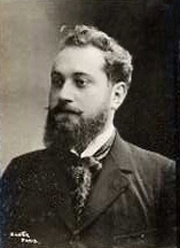
Albert Guillaume
Encyclopedia


Born in Paris, France, Albert Guillaume became a leading caricaturist during the Belle Époque
Belle Époque
The Belle Époque or La Belle Époque was a period in European social history that began during the late 19th century and lasted until World War I. Occurring during the era of the French Third Republic and the German Empire, it was a period characterised by optimism and new technological and medical...
. While remembered for his poster
Poster
A poster is any piece of printed paper designed to be attached to a wall or vertical surface. Typically posters include both textual and graphic elements, although a poster may be either wholly graphical or wholly text. Posters are designed to be both eye-catching and informative. Posters may be...
art, Guillaume also did oil paintings such as "Soirée parisienne," a portrait of Parisian dinner society. He created theater posters as well as advertising posters that were greatly influenced by the work of one of the preeminent poster painters, Jules Chéret
Jules Chéret
Jules Chéret was a French painter and lithographer who became a master of Belle Époque poster art. He has been called the father of the modern poster. -Biography:...
.
Poster Art
Guillaume thrived during the international poster mania of the Gay NinetiesGay Nineties
Gay Nineties is an American nostalgic term that refers to the decade of the 1890s. It is known in the UK as the Naughty Nineties, and refers there to the decade of supposedly decadent art by Aubrey Beardsley, the witty plays and trial of Oscar Wilde, society scandals and the beginning of the...
. During this period, a collection of notable artists helped transform the boulevards of Paris into a gallery of fine art. Toulouse-Lautrec set the stage in 1891 with his famous poster, Moulin Rouge. Other fine art posters followed and the streets came alive with color. Posters soon appeared from many of the era's great masters. Artists such as Chéret
Jules Chéret
Jules Chéret was a French painter and lithographer who became a master of Belle Époque poster art. He has been called the father of the modern poster. -Biography:...
, Livemont, Hermann-Paul
Hermann-Paul
René Georges Hermann-Paul was a French artist. He was born in Paris and died in Saintes-Maries-de-la-Mer.Recent efforts to catalog the work of Hermann-Paul reveal an artist of considerable scope. He was a well-known illustrator whose work appeared in numerous newspapers and periodicals...
and Mucha
Mucha
Mucha:* Alfons Maria Mucha , Czech artist* Bob Moha, born: Robert Mucha , a Milwaukee-based middleweight boxer* Jan Mucha * Ján Mucha , Slovak footballer...
helped shape the Parisian landscape.
Jules Chéret
Jules Chéret
Jules Chéret was a French painter and lithographer who became a master of Belle Époque poster art. He has been called the father of the modern poster. -Biography:...
is often called the "father of the modern poster." From 1895 until 1900, he collaborated with the era's great poster artists to produce a series of smaller works suitable for collectors. For six years, Chéret and his collaborators painstakingly reproduced four posters a month. The series was a smashing success. The "Masters of Posters" collection included many works by Guillaume and it was through this series that he became known to a wider audience. The collection remains popular to this day.
Caricature
Guillaume is also known for satirical drawings that were published in Parisian humor magazines such as Gil BlasGil Blas (periodical)
Gil Blas was a Parisian literary periodical founded by Augustin-Alexandre Dumont in November 1879. It was in publication until 1914...
, Le Rire
Le Rire
Le Rire, or "Laughter," was a successful humor magazine published from October 1894 through the 1950s. Founded in Paris during the Belle Époque by Felix Juven, Le Rire appeared as typical Parisians began to achieve more education, income and leisure time. Interest in the arts, culture and politics...
, L’Assiette au Beurre, and Le Figaro illustré
Le Figaro
Le Figaro is a French daily newspaper founded in 1826 and published in Paris. It is one of three French newspapers of record, with Le Monde and Libération, and is the oldest newspaper in France. It is also the second-largest national newspaper in France after Le Parisien and before Le Monde, but...
. These magazines appeared as Parisians started to acquire an increased appetite for arts, culture and politics. Guillaume lampooned the foibles of French society at a time when French governance was frequently characterized by corruption and mismanagement.
Recognition
The winner of a bronze medal at the Universal Exhibition of 1900Exposition Universelle (1900)
The Exposition Universelle of 1900 was a world's fair held in Paris, France, from April 15 to November 12, 1900, to celebrate the achievements of the past century and to accelerate development into the next...
in Paris, Guillaume had many of his illustrations published in albums by such firms as "Ernest Maindron" and "Librairie illustrée, J. Tallandier" including three albums of military cartoons with the preface for the 1896 edition written by Georges Courteline
Georges Courteline
Georges Courteline was a French dramatist and novelist.Born Georges Victor Marcel Moinaux, in Tours in the Indre-et-Loire département, his family moved to Paris shortly after his birth...
.
Death
Albert Guillaume died during the occupation in the rural village of FauxFaux, Dordogne
Faux is a commune in the Dordogne department in Aquitaine in southwestern France.-Population:...
in the Dordogne
Dordogne
Dordogne is a départment in south-west France. The départment is located in the region of Aquitaine, between the Loire valley and the High Pyrénées named after the great river Dordogne that runs through it...
département of France in 1942.
External links
- LeRire.com - Features OCR'd Le Rire issues
- L'assiette au beurre - Another belle epoque illustrated journal.

